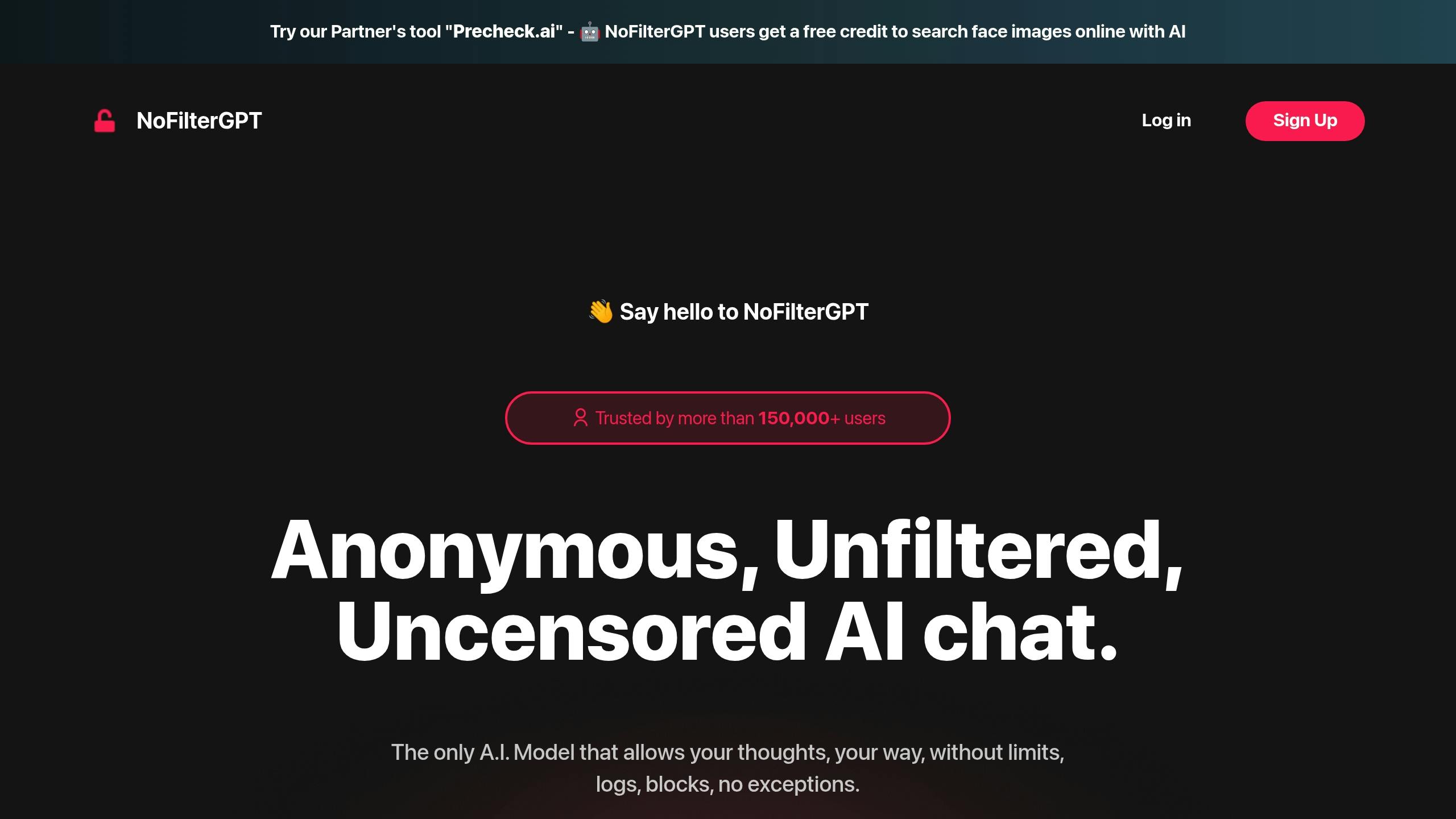- Auto Language Detection: Instantly identifies user languages for smooth conversations.
- Regional Language Processing: Understands idioms, dialects, and local expressions.
- Multi-Platform Support: Works across websites, apps, and social media.
Quick Comparison of AI Chatbot Types
| Feature | Basic Chatbots | Advanced Chatbots |
|---|---|---|
| Language Detection | Rule-based | Context-aware NLP |
| Translation Quality | Literal | Contextual |
| Cultural Adaptation | Limited | Broad |
| Learning Capability | Fixed responses | Continuously improves |
| Language Coverage | Narrow range | Wide-ranging support |
Platforms like NoFilterGPT and Avaamo lead the way with wide language support and features like encryption, multilingual content creation, and API integration. They’re ideal for businesses aiming for seamless global communication.
How To Build a Multilingual GPT-4 AI Chat Bot
Core Functions of Language AI Chat
Modern AI chat tools blend NLP, machine learning, and generative AI to enable smooth communication across multiple languages.
Auto Language Detection and Translation
AI chatbots use advanced NLP algorithms to quickly detect a user’s language and provide real-time translations. For instance, Help Scout‘s AI Assist can automatically identify and translate conversations between customers and support agents.
Avaamo supports 114 languages, including hybrids like Spanglish, Hinglish, and Singlish. It can recognize mixed language inputs and maintain context throughout the conversation.
Regional Language Processing
Handling regional language differences involves more than basic translation. AI chatbots now interpret local idioms, cultural references, and expressions using specialized language models trained on region-specific data. While language-specific models focus on cultural details, universal models rely on extensive datasets to address regional variations.
Here’s how regional processing stands out compared to basic translation:
| Aspect | Basic Translation | Regional Processing |
|---|---|---|
| Idioms | Translated word-for-word | Interpreted in context |
| Cultural References | Often misunderstood | Properly understood |
| Local Expressions | Translated literally | Adapted to cultural equivalents |
| Dialect Variations | Often ignored | Recognized and handled accurately |
Multi-Platform Support
Modern AI chat solutions connect seamlessly across websites, mobile apps, and social media using APIs and SDKs. Helpshift, for example, ensures consistent language support across various platforms, using IP-based location detection to adjust language preferences.
Imagine a Spanish-speaking customer moving from a website chat to WhatsApp. The AI retains their language preference and conversation context, providing uninterrupted multilingual support across all channels. This level of integration ensures smooth and consistent service, which is crucial for global customer satisfaction.
These features form the backbone of effective AI chat solutions, enabling their use in diverse operational scenarios.
Common AI Chatbot Categories
AI chatbots come in various types, each tailored to meet specific language and communication needs. Let’s explore how they differ.
Basic vs. Advanced AI Chatbots
Basic AI chatbots rely on rule-based systems, offering pre-set responses for simple conversations and frequently asked questions. For example, Help Scout’s AI Assist handles basic translation tasks and common customer queries.
Advanced AI chatbots, on the other hand, leverage natural language processing (NLP) and machine learning to provide more sophisticated support. These systems excel at understanding context, tone, and even cultural nuances across multiple languages. A good example is Dialogflow, which processes complex, context-heavy multilingual queries with ease.
| Feature | Basic AI Chatbots | Advanced AI Chatbots |
|---|---|---|
| Language Detection | Rule-based matching | Context-aware NLP |
| Translation Quality | Literal translation | Contextual translation |
| Cultural Adaptation | Limited | Broad and nuanced |
| Learning Capability | Fixed responses | Continuously improves |
| Language Coverage | Narrow range | Wide-ranging support |
These two categories lay the groundwork for more specialized chatbot designs.
Mixed-Type and Task-Based Chatbots
Mixed-type chatbots combine the strengths of rule-based systems with AI-driven features, offering flexibility for various tasks. For instance, IBM Watson Assistant uses both predefined rules and machine learning to handle complex interactions seamlessly.
Task-based chatbots are built for specific purposes. A great example is Avaamo’s banking chatbot, designed to perform financial tasks while adapting to regional terminology. These specialized bots often deliver higher accuracy in their respective domains compared to general-purpose chatbots.
This classification helps businesses choose the right chatbot to close language gaps and meet their specific needs effectively.
Setting Up a Multi-Language AI Chatbot
Creating a multilingual AI chatbot involves more than just adding multiple languages. It requires thoughtful platform choices and precise configurations to ensure smooth and effective communication.
Choosing the Right Platform
To get started, you’ll need a reliable platform. Options like Dialogflow, Amazon Lex, and IBM Watson are popular for their advanced features and performance.
Here are some factors to evaluate when choosing your platform:
| Feature | What It Does | Example Platform |
|---|---|---|
| Language Coverage | Supports a wide range of languages and dialects | Dialogflow (broad language support) |
| NLP Capabilities | Ensures accurate natural language understanding | IBM Watson (strong NLP capabilities) |
| Integration Options | Works well with your existing systems | Amazon Lex (fits into AWS ecosystem) |
Once you’ve chosen a platform, you’ll need to configure language models to handle the nuances of different regions and cultures.
Configuring Language Models
To maintain high-quality interactions, set up language-specific models. This ensures your chatbot understands and responds appropriately in each language.
Key components for configuration include:
- Intent Recognition: Train the chatbot to grasp user intentions across all supported languages.
- Entity Detection: Customize entity recognition for each language to handle proper nouns and terms correctly.
- Response Generation: Create response templates that align with cultural norms and expectations.
Setting Up Translation Systems
For seamless communication, integrate translation tools and enable automatic language detection. Here’s how:
- API Integration: Use trusted APIs like Google Translate or build a custom solution. For example, Help Scout’s AI Assist can translate customer replies into various languages.
- Language Detection: Configure your chatbot to detect user language preferences automatically. This can be based on browser settings, location, or user selection.
- Validation: Collaborate with native speakers to test translations and ensure they align with cultural contexts. This step is essential for delivering accurate and meaningful interactions.
sbb-itb-85d5e64
Tips for Better Multi-Language Chatbots
Creating effective multilingual chatbots involves focusing on key areas that shape user experience and ensure smooth communication.
Conversation Context Management
Keeping conversations consistent across languages can be tricky, but it’s crucial for a seamless user experience. Tools like Zendesk‘s intelligent triage system help maintain context effectively.
Key strategies include:
- Conversation memory: Store user preferences and past interactions to personalize responses.
- Language-specific knowledge bases: Tailor responses to fit cultural nuances and expectations.
By addressing cultural differences, chatbots can better connect with users and break down language barriers.
Error Response Systems
When errors happen, clear communication is essential – especially in a multilingual setup. Chatbots should:
- Detect issues quickly.
- Display error messages in the user’s preferred language.
- Provide fallback options, like language selection or clarification prompts.
This approach ensures users stay engaged, even when something goes wrong.
Expanding Language Support
Adding more languages requires careful planning. Start small and grow strategically:
- Focus on core languages first.
- Validate translations with native speakers to ensure accuracy.
- Continuously monitor performance and gather user feedback to improve.
NoFilterGPT: Multi-Language AI Chat Example

NoFilterGPT focuses on breaking down language barriers with its AI chat platform, designed for secure and effective multilingual communication.
Main Features
NoFilterGPT uses advanced natural language processing (NLP) to support a wide range of writing systems, such as:
- Cyrillic, Devanagari, and Chinese
- Hangul, Greek, and Hebrew
- Japanese Kana, Thai, and Arabic
It also includes AES encryption for security and automatic language detection, making it suitable for various industries.
Common Applications
NoFilterGPT’s features open the door to several practical uses:
| Application Type | Implementation Example |
|---|---|
| Customer Support | Detects the user’s language and provides accurate replies |
| Content Creation | Produces multilingual content with localized context |
| Research | Analyzes multilingual data seamlessly |
| Business Communication | Facilitates real-time translation for global teams |
Available Plans
NoFilterGPT provides two pricing options to suit different needs:
| Plan | Cost | Key Language Features |
|---|---|---|
| Basic (Free) | $0 | • Basic language detection • Limited daily messages • Custom GPT tone |
| Professional | $5.80/month | • Unlimited multilingual chats • Advanced NLP tools • API for integration • Image analysis |
The Professional plan includes priority support and access to the latest language models, making it ideal for businesses seeking advanced multilingual tools. The API supports integration with Python, PHP, and JavaScript, allowing for seamless customization.
"NoFilterGPT stands out for its advanced NLP capabilities and robust translation system."
Its ability to maintain context while switching between languages in real-time makes it a strong choice for global business communication.
Conclusion
AI chat tools powered by NLP and machine learning have transformed global communication, breaking down language barriers and enabling smoother interactions across different languages and writing systems.
This shift goes beyond just technology – it has changed how users interact with platforms. Many services now provide multilingual customer support that maintains both accuracy and context, making interactions more meaningful.
The technology behind multilingual AI chat continues to advance. Language models that address dialects and regional variations are proving essential for serving diverse markets, as they capture subtle cultural and linguistic differences.
For organizations planning to implement multilingual AI chat tools, success hinges on choosing platforms with features like auto-detection, regional processing, and error management. These systems play a direct role in improving customer satisfaction.
"Multilingual AI chat tools significantly enhance customer satisfaction and engagement by providing personalized support in users’ native languages. This leads to improved understanding, reduced frustration, and increased loyalty among global customers."
As AI chat models evolve, they are becoming better at understanding cultural contexts and regional languages. These advancements build on the capabilities discussed in this guide, paving the way for even more effective solutions for businesses worldwide.
Platforms like NoFilterGPT highlight the importance of multilingual AI chat tools, offering businesses the means to achieve seamless global communication and improve operational workflows.
FAQs
This FAQ highlights common questions about open-source solutions and builds on earlier discussions about multilingual platforms.
Is there an open-source AI chatbot?
Yes, Botpress is a well-known open-source platform that supports multiple languages. It uses advanced Natural Language Understanding (NLU) libraries to create chatbots that require very little training data.
Some of its main features include:
- Visual flow builder for designing conversations
- Support for multiple NLU libraries
- Intent recognition and entity extraction
- Slot-filling for better contextual understanding
Here’s a quick comparison of multilingual AI chatbot options:
| Platform | Type | Key Features |
|---|---|---|
| Botpress | Open-source | Visual flows, low training needs, customizable language options |
| Proprietary Solutions | Commercial | Enterprise-grade support, pre-built integrations |
When using open-source chatbots, ensure accurate language mapping and adjust industry-specific terms to maintain consistent support across various regions.






